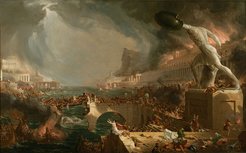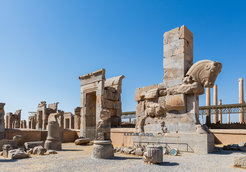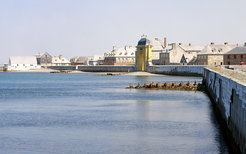
Systems Archaeology Research Group
“Perhaps the search for regularities in human history is becoming a trifle more respectable than it was formerly. That could well portend some significant improvement in our ability to discuss the human future.” Murray Gell-Mann, recipient of the Physics Nobel Prize & co-founder of the Santa Fe Institute
In the quest for Gell-Mann’s vision, the Systems Archaeology research group is developing the field of Historical Science based on dynamical systems theory. We employ interdisciplinary methods to accurately and precisely describe past human activities and their environmental contexts across space and time. Modelling applied to large amounts of diverse paleo-data is then used to investigate the causal mechanisms behind past societal dynamics. Our ultimate goal is to produce historical knowledge that can be usefully employed by risk analysts and policymakers tackling present-day collective challenges. Currently, we pursue the following research topics:
- Human agency in complex dynamical systems
- Emergence and impact of technological innovations
- Formation of networks for the exchange of materials and information
- The rise and demise of past societies
- Feedback mechanisms among human, environmental, and climatic systems
- Interplay between socioeconomic inequality and societal dynamics
A structural activity of our research group is the advancement of Big Historical Data following FAIR and CARE principles via the Pandora & IsoMemo initiatives. Another component of these initiatives is the development of advanced open-source modelling tools to reconstruct various aspects of past human-environmental systems and to investigate historical causation (further details below under Pandora & IsoMemo project). This work is carried out under the Computational Archaeology lab (CA lab) and in collaboration with several international institutions.
Our research group also produces new data. We oversee the running of the Radiocarbon lab (14C lab), a clean wet chemistry facility hosting a Ionplus AGE 3 automated graphitization equipment and portable XRF and FTIR devices to assess sample preservation. In collaboration with the AMS facility of the Max Planck Institute for Biogeochemistry we employ radiocarbon to set the chronologies of past events and as a tracer to investigate a variety of environmental phenomena. We also oversee the running of the Biochemistry lab, equipped with a Gas Chromatography Combustion Isotope Ratio Mass Spectrometer (elementar isoprime visION System), a Gas Chromatography Mass Spectrometer (Agilent 8890), and a liquid chromatography system with a triple quad mass spectrometer (Shimadzu LCMS 8050). In collaboration with the Stable isotope group, we employ isotopic methods to study past societies and environments and we carry out fundamental research to expand their range of applications.
Projects
Pandora & IsoMemo Initiatives for Big Historical Data Compilation and Modelling
Project members: Sean Hixon, Carlo Cocozza, Marcus Groß, Jian Roachell, Traci N Billings, Adam Izdebski, Patrick Roberts, Ricardo Fernandes

An effective understanding of past historical dynamics under a systems approach requires large volumes of diverse data. This should be structured as linked open data so that different systems’ components can be efficiently connected. To achieve this, we developed the Pandora data platform in collaboration with the Max Planck Computing and Data Facility and the Max Planck Library plus c. 60 international partners. Pandora is a grassroots initiative promoting the creation of independently managed data communities and wider collaborative data networks. Among these is the IsoMemo network connecting c. 40 open-access databases that compile isotopic data informing on the environmental history of the Earth and of its human inhabitants from the deep past until the present day. Amassed data via Pandora is used to test historical hypotheses and in data-driven approaches that seek to identify historical patterns.
We are also developing novel R modelling tools for historical research. These are made available online via the Pandora & IsoMemo open-source software platform and are designed to address typical aspects of historical data such as missing data, data uncertainties, and reliance on expert information. We employ Bayesian modelling of proxy data and expert inputs to produce high-resolution reconstructions of various aspects that characterized past human-environmental systems. Machine learning techniques, such as Bayesian networks and non-linear model selection algorithms, are used to study historical causation. We develop and/or collaborate in the development of models and software to investigate various aspects of complex systems such as the study of cyclical human and environmental phenomena, detection of critical transitions and their warning signs, simulation of emerging phenomena using agent-based modelling, and in network analysis.
The Pandora & IsoMemo initiatives are also involved in direct data collection efforts although this is mostly carried out by network members. There are several research projects underway that apply newly developed modelling tools to compiled datasets. This includes projects investigating the spread of peoples, domesticates, and technologies at continental scales; determining the causes of species extinction; and surveying un/successful human adaptions to climate change.
Using Artificial Intelligence for Historical Research
Project Members: Jian Rochell, Ricardo Fernandes

Several artificial intelligence techniques, such as large language models, are being developed for applications in historical research and their contributions to contemporary policymaking. This includes a collaboration with the Max Planck Library to automate the process of tracking and extracting expert evidence from written publications. This AI system can efficiently locate expert statements on a selected topic and generate a concise summary review. We plan to utilize this AI system to evaluate expert consensus, verify the level of expertise, and seamlessly incorporate expert evidence into historical models. Furthermore, we are employing AI methods to accelerate the process of creating structured historical databases from diverse textual sources. Another application involves the integration of AI with Agent-Based Models for system-of-systems simulations, where AI is used to test the consequences of various policies within the dynamics of different systems, such as political, economic, cultural, and environmental systems.
A Systems Approach to the Study of the Collapse of the Western Roman Empire
Project members: Jian Rochell, Ricardo Fernandes

The collapse of the Western Roman Empire has long been a subject of scholarly research and of public interest. Yet, the exact causes behind the collapse still elude us. Famously, Alexander Demandt enumerated 210 different collapse causes from published literature. In revisiting this topic, we employ a multivariate approach based on complex systems theory that considers the interactions among various human-environmental sub-systems (e.g. socio-economic, political, cultural, technological, environmental, and climatic). To characterize past systems we collect and standardize previously published data plus carry out new data collections. Novel modelling methods for the study of historical causation will be applied to amassed data. In the future, we plan to employ similar approaches in the study of other past societies.
Human Lifeways in the Ancient Mediterranean and its Periphery
Project members: Carlo Cocozza, Dominika Schmidtová, Linda Melicherová, Ricardo Fernandes

In recent years the Mediterranean region has been a focal point in international affairs as economic crashes, armed conflicts, and dwindling natural resources triggered by climate change have resulted in a wide range of responses from mild social unrest to large-scale humanitarian crises and mass migrations. Such issues are not new and Mediterranean societies experienced throughout their history the consequences of climatic, environmental, pandemic, and armed conflict events. The goal of this project is to improve our understanding of the repercussions that such events had on the lifeways of ancient populations in the Mediterranean region and its periphery. We employ multi-proxy approaches (e.g. isotopes, osteological analyses, archaeofaunal and archaeobotanical studies) and Bayesian modelling to reconstruct the living conditions and productive activities of past populations and to set these in their historical and environmental contexts. The project relies on novel site studies (e.g. Sparta, Athens, Rome, Ostia, Pompeii, and Persepolis) and on standardized compilations of published data.
Developing Multi-isotope Methods for the Study of Past Human-Environmental Systems
Project members: Sean Hixon, Ricardo Fernandes

Our research group produces novel historical and paleo-environmental data via the Radiocarbon and the Compound Specific Isotopic Analysis laboratories. The latter is under a joint directorship with the Biochemistry research group and the former is part of a collaboration with the AMS laboratory of the Max Planck Institute for Biogeochemistry. Isotopes are an eclectic research tool used to set chronologies and to investigate past human living conditions, economic activities, exchange networks, technological developments, and paleo-environmental and -climatic conditions. Fundamental research is undertaken to widen the range of information that can be obtained using isotopic methods, improve the accuracy and precision of paleo-reconstructions, and ensure the protection of cultural heritage. We develop novel lab protocols to be applied in the analysis of archaeological samples, set up procedures to determine sample preservation using portable FTIR and XRF devices, and rely on advanced mass spectrometry techniques to produce measurements for a variety of isotopic proxies.
Globalizing Scents and Spices: Tracking the trade of aromatics through biomolecular archaeology
Project leader: Barbara Huber

Long-distance trade of commodities played a major role in forming political structures and transferring socio-cultural practices among the major centres of ancient civilization in the Old World. Some of the most high-value products that moved along ancient trade routes, were not substantive, calorie-laden foods, but resins, powders, extracts, and obscure dried plant components that nonetheless packed substantial flavour and aroma. Not only did these substances possess the ability to transform cuisines and to scent people and spaces, they also often played significant roles in economic, cultural, medicinal and ritual contexts.
This project aims to investigate the global dimensions of the dispersal of these so-called spices throughout Asia and East Africa. This includes not only the spread of goods, but also the transfer of socio-cultural practices associated with their use. To trace these often “invisible” substances in the archaeological record, Barbara seeks to study organic remains of them by using biochemical and biomolecular approaches. These draw on chromatography, mass spectrometry, and bioinformatics to recover and analyze rare molecules (secondary metabolites, lipids and proteins) preserved within ancient ‘scent archives’. These archives can be archaeological artefacts, such as incense burners, perfume flasks, cooking pots or storage vessels found at different sites along ancient trade routes. Other features such as dental calculus on teeth, mummified remains, or floor surfaces can also function as archives. The most important property of such scent archives is that they contain the remains of aromatic substances used in the past that can be sampled, analysed and identified. Through this approach, the individual aromatics can be pinpointed at places of origin, at the different stops of the trade routes and at destinations, allowing not only to reconstruct ancient trade, exchange systems distribution ranges of these goods, but also to study past networks and connectivity.
Exploring funerary and embalming rituals in ancient Egypt through metabolic profiling
Project leader: Barbara Huber

Ancient Egyptian mummification involved a cocktail of plant mixtures, colloquially referred to as embalming fluids, specifically used to preserve the body as well as human organs for the afterlife. The embalming rituals were practiced throughout most of Egyptian history and continued through the Roman period, making them a characteristic feature of Egyptian funerary archaeology. However, the ingredients used in this process remain poorly identified and historian and archaeologists have widely discussed their identities.
In this study, we integrate complementary approaches in metabolomic profiling and lipid residue analysis to shed light on the identity of the ingredients used during mummification. Furthermore, practices involved in body treatment and preparing the deceased for the afterlife, which are reported in ancient texts, can be complemented by the actual substances and remedies used to preserve these organs.
Prehistoric Human Modification of Madagascar’s Terrestrial Ecosystems
Project leader: Sean Hixon. MPI GEA project collaborators: Noel Amano, Thomas Larsen, Patrick Roberts

Loss of biodiversity is one of the most urgent threats to ecosystems, particularly on tropical islands such as Madagascar. Effective conservation efforts should be informed by assessing the combined threats of deforestation, biological invasions, and climate change, which operate on multiple timescales. This project uses proxy data from the bones of both human-introduced animals (e.g., livestock, dogs, and rodents) and endemic animals (e.g., extinct megaherbivores and extant mouse lemurs and rodents) to estimate taxon-specific responses to past changes in resource availability during the past ~3,000 years. Radiocarbon data from bones helps to both 1) refine estimates of animal extinction and introduction during the past ~2,000 years and 2) ties animal proxy records to regional records of climate and vegetation change. These lines of evidence can be integrated with modern datasets to help infer some of the environmental tolerances and interspecific interactions that likely shaped Madagascar’s ecological communities over recent millennia.
Tracing dietary practices at the Fortress of Louisbourg, Nova Scotia, Canada (1713-1758)
Project members: Alison Harris, Ricardo Fernandes

The present system of globalisation and the increasing interdependence of disparate human populations is rooted in the mass migration of people, non-human animals, crops and cultural beliefs from Eurasia to the Americas, Asia, Africa and Australia. In some regions, culinary traditions were easily superimposed onto a new landscape, while in other environmental contexts it was necessary to adapt dietary practices to align with available food resources. The Fortress of Louisbourg, in Nova Scotia, Canada, flourished in the first half of the 18th-century, protecting French cod fishing interests in the North Atlantic. The fortress drew residents, migratory fishers, and soldiers from Newfoundland, France, New France, and, after 1745, from the New England colonies of Massachusetts, Connecticut, and Rhode Island. With such a diverse population, the Fortress of Louisbourg presents an intriguing example of the persistence and adaptability of food systems on the rocky coast of Cape Breton. This project uses stable isotope analysis of bone, dentine collagen and amino acids, human osteology, and statistical modelling to explore the fluidity and resilience of dietary systems in an increasingly connected Atlantic world.
Amino acid isotope investigations of infant feeding and physiology
Project members: Alison Harris, Sean Hixon, Ricardo Fernandes

The investigation of infant feeding practices is critical for understanding trends in infant mortality, long-term health and population demographics, the socioeconomic roles of women, and family dynamics and subsistence. Stable carbon and nitrogen isotope analysis of bulk bone and dentine collagen revolutionized the way infant feeding practices are studied in the archaeological record. These methods have allowed us to obtain direct dietary information from individuals that can be interpreted against other skeletal markers of health and social status. In this project, we take the isotopic analysis of ancient skeletal proteins one step further by measuring isotopes of carbon and nitrogen in the amino acids that compose collagen (from bones and teeth) and keratin (finger nails). We aim to develop more sensitive proxies to identify the duration of exclusive breastfeeding, the types of foods provided to infants, and to distinguish between dietary and physiological sources of isotopic variation in human skeletal remains from archaeological sites across the North Atlantic world.









